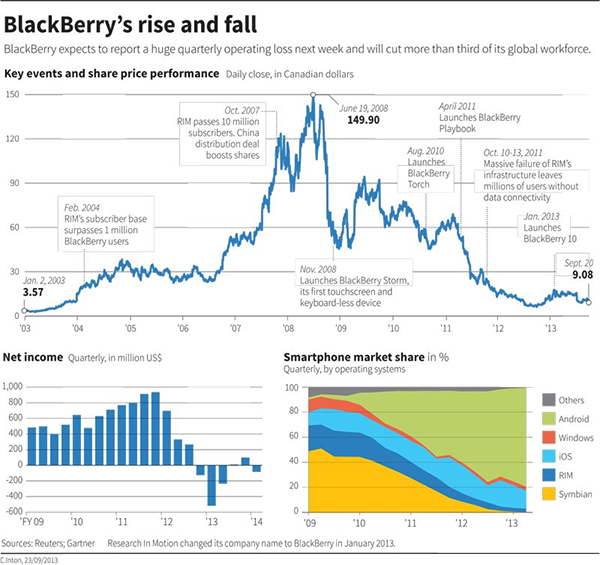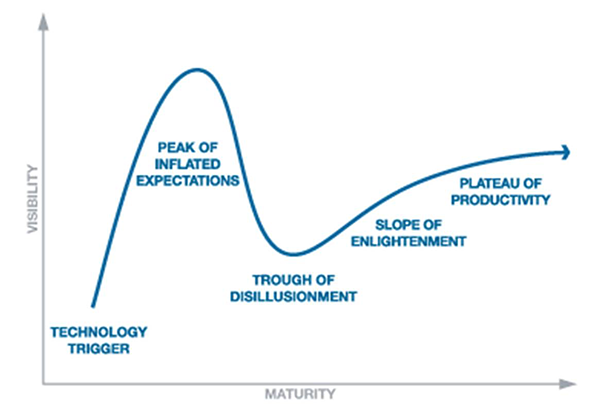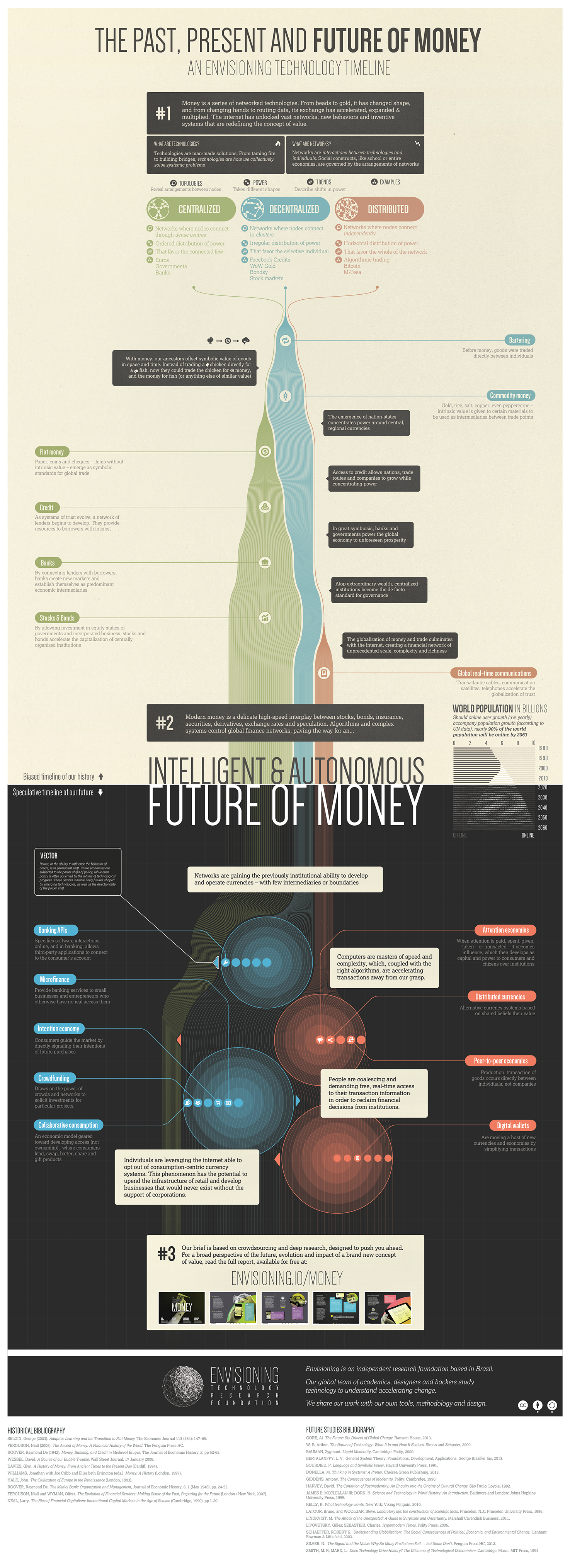EMERGING TECHNOLOGY
Another facet of being able to help a business react to an emerging technology is to become well informed on the mechanics of technological emergence and to understand what constitutes an emerging technology. One might begin by looking at literature on emerging tech and examining some of the forecasting that has been done on the subject. These activities made up a bulk of this project’s discovery process with the result being a relatively comprehensive menu from which to choose a technology and an adequate amount of knowledge to make an informed decision.
Hypothesis: Experience designers are better suited for evaluating the potential value or impact of emerging technologies.
What is an emerging technology?
From an academic standpoint, an emerging technology isn’t simply a new product but something more specific. Current literature on the subject, however, is not in consensus about what properties constitute an emerging technology. Nevertheless, one can begin to understand what is meant by the term by first looking at what it means to be emergent. There are two primary definitions that are relevant to this discussion. The first is that emergence is “the process of coming into being or becoming prominent” (New Oxford American Dictionary). This differs slightly from a second definition that may be worth considering and which is rooted in a philosophical context. This alternate definition defines emergence as “arising as an effect of complex causes and not analyzable simply as the sum of their effects” (New Oxford American Dictionary). Hicks et al. looked these definitions in their paper What is an emerging technology? Their conclusion is “in the phrase ‘emerging technology’, ‘emerging’ is generally understood in the standard sense, not the complex system usage” (Hicks et al., 2014). This is useful as it closes off a number of innovations or inventions from being classified as an emerging technology such as new, innovative business models for instance, which are the result of interaction between a number of complex systems such as customers experience, supply chain management, organizational structure, etc. Hicks et al. go on to present a specific definition of what qualifies as an emerging technology as
“a radically novel and relatively fast growing technology characterized by a certain degree of coherence persisting over time and with the potential to exert a considerable impact on the socio-economic domain(s) which is observed in terms of the composition of actors, institutions and patterns of interactions among those, along with the associated knowledge production processes. Its most prominent impact, however, lies in the future and so in the emergence phase is still somewhat uncertain and ambiguous (Hicks et al., 2014). "
This is obviously not the most succinct of definitions which should stand as a testament to the specificity of the term. Furthermore, emerging technologies do share the feature of their temporality in that any technology’s status as emerging is delicate and subject to change (Kjedskov, 2003). Considering the macro-trend of rapid technology adoption happening in recent years, technologies that are emerging, don’t stay emerging for long.
Forecasting Emerging Technology
Though reasonable efforts have been made to clarify what is meant by the term “emerging technology” it is more crucial to designers and businesses to accurately predict the futures of emerging technologies. As with many other things, there is a delicate balance that needs to be struck between adopting the right technology as a response to market forces and customer demand and adopting the right technology as a means of differentiation from your competition. In the former, a business should be careful to allocate resources in relation to an emerging technology that will become an unavoidable influence on an industry. For example, take the laserdisc technology that was briefly popular in the 1980s and 1990s. This was considered an emerging technology by many and a number of firms who produced content bet on the success of the platform, only to see it quickly fall out of favor among consumers (Samit, 2015). In this example the firms who produced video content had to make a prediction on what would be the dominant platform for video distribution and allocate resources accordingly, that is to say, these firms had to respond to an emerging technology. On the other hand, emerging technology might effect a business by representing an opportunity for differentiation. An example of this scenario can be illustrated by the emergence of touchscreen technology in the mobile phone industry. Some firms such as Apple and LG chose to develop phones with touchscreen to create a better user experience while some firms like Blackberry chose not to pursue touchscreen technology based on the expectation that their current users valued the tactile response of a mechanical keyboard (Shaughnessy, 2013). Blackberry, of course, started to hemorrhage market share.
"BlackBerry proves that Andrew Grove really did have it right when he said ‘only the paranoid survive.’ That’s probably the best lesson CEOs can take away from BlackBerry’s fall (Nelson, 2013)."
Apple and LG represent firms that successfully leveraged an emerging technology. These ideas of leveraging versus responding may also be represented by the dichotomy of internal versus external. The leveraging of a technology is when a business adopts a technology and develops it internally, and the inverse of this is a company feeling external pressure from the emergence of a technology and being forced to respond.


Decline of Blackberry Chart from Business Insider via Reuters (Weisenthal, 2013)
Evaluating Emerging Technologies
When looking for which technologies to consider there is a significant body of research that is conducted year in and year out by various firms. The forecasting of emerging technologies is a field of research in of itself with one of the most prominent players being Gartner.
"Choosing the right technologies - and being aware of the options - is critical (Collins and Williams, 2014)."
The Gartner Hype Cycle consists of a technology lifecycle curve that aims to plot emerging technologies against the variables of visibility and maturity (Gartner, 2016). When considering which technology to focus on, the Gartner Hype Cycle can provide a starting point. However, the Gartner Hype Cycle is not the only source one could consider when making a choice.
Gartner Hype Cycle


(Gartner, 2016)
Other firms such as envisioning.io produce high-quality visualizations of emerging technology trends and future forecasts (envisioning.io). I spoke with Michell Zappa, the founder of envisioning about a range of topics. However, on the subject of technology forecasting, in which he is an expert, he pointed out that the Gartner Hype cycle often lacks consistency between the years of their publishing meaning that some technologies have moved backwards against their emergence curve which is problematic (Zappa, 2016). Michell goes on to point out issues with the Gartner Hype Cycle on a fundamental leavel by saying that they [Gartner], "forces this secondary dimension of hype onto a readiness curve." This is a problem because there is not always a correlation between the maturatity of a technology and its associated hype (Zappa, 2016).
Looking at the list of these technologies can be dizzying or even mind-bending and it takes a skilled individual to cut through marketing campaigns and media buzz to determine a given technologies potential and relevance to a business.
Future of Money (Envisioning.io)
"The selection of technologies is one of the most challenging decision making areas the management of a company encounters. It is difficult to clarify the right technology alternatives because the number of technologies is increasing and the technologies are becoming more and more complex (Torrkeli and Touminen, 2001). "
To make these choices Collins and Williams propose a 3-stage filter that includes identifying technologies with key attributes, then evauluating the technologies more closely to elimate some, and then to finally evaluate the final technologies contextually. They also say that these steps should be undertaken by technologists and managers of the research team (Collins and Williams, 2014). Notice the lack of "design" in their reccomendation. If evaluating the potential of technology involves imagining how that tech might be used then at this point it seems as though an experience designer might be valuable on the basis that a core feature of the design process is idea generation (Lugt, 2005). A design led approach to idea generation has been proven useful in a number of studies such as the one conducted by Law et al. After conducting research on the idea generation process of students in Hong Kong it was recommended by the authors that a Western approach to design learning, one that focuses on design process, should be used to stimulate idea generation (Law et al., 2013). Additionally, in an interview with me, Michell Zappa says that,
"Design is high on the list of everything we do. Visual design, conceptual design, user experience, but also we're applying design thinking principles. That's a big one (Zappa, 2016)."
Given that we are seeing an increase in the rate of technological proliferation, and a shortening of the emergent technology lifecycle, it is more crucial than ever for businesses to be efficient and prolific in their idea generation and future scenario considerations. They would be wise to rely on designers for this task.












